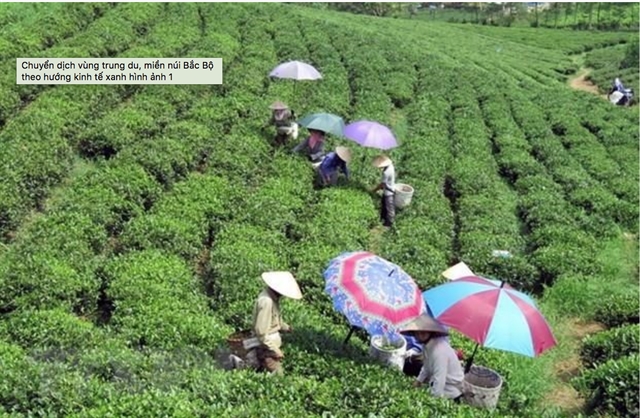 Politics & Law
Politics & Law


|
| A tea field in the midland province of Thái Nguyên. — VNA/VNS Photo |
HÀ NỘI — Standing Deputy Prime Minister Phạm Bình Minh has just signed Resolution 96/NQ-CP on the Government's action plan for socio-economic development and national defence and security assurance in the northern midland and mountainous regions by 2030.
Under the action plan, the Government set specific targets for socio-economic development for the regions.
The Gross Regional Domestic Product (GRDP) growth in the period of 2021-2030 will reach 8-9 per cent per year, and by 2030, the economic scale of the region will reach about VNĐ21 trillion (US$90.5 billion), of which agriculture, forestry and fishery will account for 12-13 per cent, industry and construction 45-46 per cent, and services 37-38 per cent.
The GRDP per capita will be VNĐ140 million ($6,000) per year (at the current price), and the total state budget revenue will reach about VNĐ190 trillion ($8.1 billion).
The urbanisation rate is about 40 per cent, and 80 per cent of communes meet new rural standards, of which 30 per cent meet improved rural standards, and each province has at least three district-level units meeting new rural standards.
Regarding the labour force, the rate of trained workers reaches 65-70 per cent, 35-40 per cent of whom have occupational degrees and certificates.
The provinces set a target of decreasing the poverty rate by 2- 3 per cent per year.
In terms of healthcare services, the provinces strive to reach a target of 32 hospital beds per 10,000 people, 11 doctors per 10,000 people, and 100 per cent of commune health stations that can treat several non-communicable diseases.
Health insurance coverage is over 95 per cent of the population.
The coverage rate of forests is set to reach 55 per cent, while the percentage of people supplied with clean water is 95-100 per cent for urban areas and 93-95 per cent for rural areas.
The collection and treatment of hazardous and medical waste must reach 90 per cent while solid waste reaches 100 per cent.
All industrial parks and industrial clusters have standard wastewater treatment systems.
Regional economic centres
One of the solutions to achieve the above goals is to complete the legal framework and institutions for development and regional linkage.
Specifically, relevant offices have to complete development planning for the northern midland and mountainous regions in the 2021-2030 period, and detailed plans for each locality in the areas, ensuring that connectivity, synchronism, unity, efficiency and sustainability, to develop urban areas connecting with major cities in Hồng (Red) River Delta, linkage chains, and economic centres in border areas.
It is necessary to form regional economic development centres in provinces of Thái Nguyên, Bắc Giang, Lào Cai, Sơn La and Lạng Sơn as well as develop economic corridors connecting Hà Nội with provinces of Bắc Giang, Lạng Sơn, Cao Bằng, Hòa Bình, Sơn La, Điện Biên, Lào Cai, Hải Phòng, Thái Nguyên, Bắc Kạn, Tuyên Quang, Hà Giang, Phú Thọ, Vĩnh Phúc, Hưng Yên, and Hải Dương.
It needs to form a chain link in the Bắc Giang-Thái Nguyên-Phú Thọ belt in association with Hà Nội as well as establish value chains of regional industries and products such as high-level manufacturing centres of electricity, electronics and mechanical production in Thái Nguyên and Bắc Giang provinces; an agricultural product processing centre in Sơn La; wood production and processing in Tuyên Quang; and a centre of economic trade connection between Việt Nam and ASEAN countries and southwest China in Lào Cai Province.
Establishing operational regulations of the Northern Midlands and Mountainous Area Co-ordinating Council is necessary and to soon adjust and supplement current mechanisms and policies to better meet specific conditions in regional development.
One of the top priorities is to develop a socio-economic infrastructure system, especially transport infrastructure, digital infrastructure and smart electricity and electronics production centres associated with economic corridors.
By 2030, localities must complete expressways and highways to connect provincial and border belt roads.
In 2021-2025, highway projects of Hữu Nghị-Chi Lăng, Tuyên Quang-Phú Thọ, Chợ Mới-Bắc Kạn, Tuyên Quang-Hà Giang and Lai Châu- Nội Bài-Lào Cai must be completed.
Regarding aviation, Sa Pa Airport in Lào Cai Province will be built in the form of a public-private partnership, and the current Điện Biên Airport in Điện Biên Province will be upgraded.
Socio-economic development must be associated with accelerating regional economic restructuring towards a green and circular economy and promoting science and technology and digital transformation.
It is essential to develop an innovative start-up ecosystem connecting and co-operation among universities and research institutes with the industrial sector and businesses.
The regional industry sector should be developed by applying advanced and environmentally friendly technologies and focusing on processing, manufacturing and energy industries.
Meanwhile, regional agriculture should focus on highly efficient commodity agriculture with safe organic products and forming specialised farming areas.
In rural areas, people can promote the development of eco-tourism and community-based tourism in association with preserving unique traditional cultural values.
Management and effective use of natural resources and land, environment and natural disasters and climate change response must be paid more attention. — VNS




